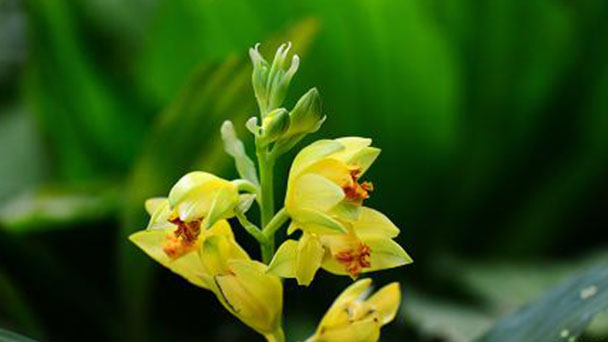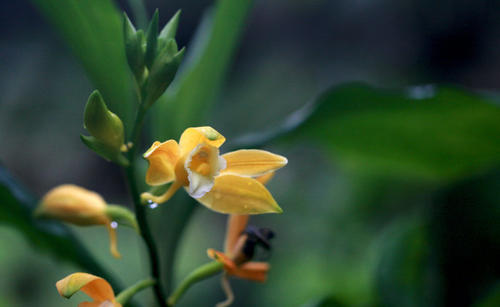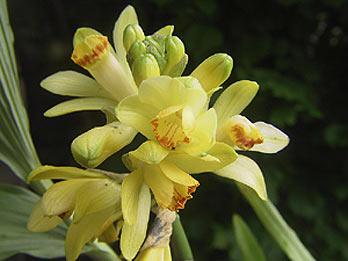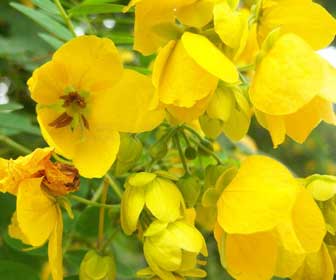Phaius flavus profile
Written by Maggie
Jan 15 2021

Phaius flavus, pseudobulb cone oval, 4, 6, alternate on upper pseudobulb closely, usually with yellow patches, long elliptic or elliptic-lanceolate, scapes showed from pseudobulb base or base on the top of the section, 1 -- 2, erect, stout, how many flat cylindrical or cylindrical, not upper leaf layer, not branched or occasionally base with branches, glabrous, hydrophobic number of about 3 cm long membranous sheath; Racemes are up to 20 cm long, with several to 20 flowers, flowering from April to October, in Fujian, Taiwan, northern Hunan, Guangdong, Guangxi, Hong Kong, Hainan, Guizhou, Sichuan, Yunnan, and southeastern Xizang. Phaius flavus was born in the elevation of 300-2500 meters of the slope under the damp forest.
Phaius flavus picture

Morphological characteristics of Phaius flavus
Bulbs are cylindrical or conical, ca. 10 cm tall, with bracts forming pseudostems up to 60 cm; Leaves 3 ~ 8, are about 45 cm long, 11 cm wide, lanceolate, with irregular yellow spots or streaks. phaius flavus sprouts from the base of the false bulb, up to 90 cm in height, with many flowers, fragrant flowers, long flowering period, about 7.5 cm in diameter, light yellow. There are some brown or reddish brown spots on the lip, petals smaller than sepals, the lip is tubular. It blooms in spring and has a long flowering period. It is an excellent indoor potted flower.
The growth habits of Phaius flavus
Phaius flavus was born in the elevation of 2100-2200 meters valley stream, under the forest. It can be found in most areas south of Yangtze River.
Cultivation of Phaius flavus
Water management
4 parts of humus soil, 1 part of river sand or ground moss, 3 parts of peat soil, 1 part of sand or ground moss can be used as pot medium. Change the pot or soil before the spring buds; Potted pot when the lower 1/4-1/3 filled with coarse granular pieces of broken brick, broken tiles, for basin soil drainage and ventilation; Because the plant leaves lush, strong growth potential, need more fertilizer, in addition to adding part of the base fertilizer in the culture soil, in the growth period, it should be every 2-3 weeks to apply liquid fertilizer, stop fertilization after the temperature drops at the end of autumn;

Temperature and light control
Spring, summer and autumn can shade about 50%; No shading or less shading in winter; In the domestic indoor it can be put near the window of the sun, and it had better have 2, 3 hours of direct light daily; Outdoor direct sunlight is harmful, because its leaves are thin, will become brown due to sun burning; In summer we should cover the sun shading net appropriate shading; Usually overwintering in a medium-temperature or high-temperature greenhouse, the lowest temperature at night above 12℃; However, it was reported that the most popular cultivated Orchidaceae had strong cold resistance, which could be propagated by seedling and aseptic sowing under low temperature of about 4℃ for a short time.Warm, moist and semi-cloudy conditions are required. Potted with fertile, loose and well-drained humus soil. In winter it is relatively dormant, keeps basin soil moisture, and should not water too much. The overwintering temperature should be above 6℃.
The propagation of Phaius flavus
It can be propagated by aseptic seeding and tissue culture. In general, division propagation is the most; Usually in the spring before the new bud germination or after the flowering of the short dormant period combined with changing the pot for plant division; The robust plants can be divided every 2 to 3 years. Pour the plants out of the pot, remove the old vegetative soil, and then carefully separate the densely growing clusters of pseudobulbs, so that every 3 pseudobulbs form a cluster, with new buds, so as not to affect the flowering; When planting the side of the new bud towards the basin, and set aside the location of growth for 2 to 3 years, planting depth to make the lower part of the false bulb about 1 cm buried in the soil is appropriate;
The medicinal value of Phaius flavus
Phaius flavus stems have the effect of clearing heat cough, activating blood to stop bleeding, curing cough, sputum hemoptysis, trauma bleeding, etc..

Latest Updated
- Benefits of Bugleweed - 7 Science-backed Health Benefits
- Bugleweed Dangers & Side Effects - Is It Poisonous?
- How to Plant Evergreen Trees - What You Should Know
- When to Plant Evergreens - Grow Guide for Evergreen Trees
- 12 Wonderful Evergreen Shrubs for Your Garden
- 12 Popular Evergreen Plants with Pictures for Beginners
- When And How To Prune A Lilac Bush Like a Pro
- How to Grow & Care for Lilac Vine (Hardenbergia Violacea)
- Japanese Lilac Tree (Syringa Reticulata) Care & Propagation Guide
- Shumard Oak Pros and Cons - What to Know
Popular Articles
- Winter maintenance of Antirrhinum Majus
- How to Grow Terminalia Mantaly Tree
- How to Grow and Care for Crossostephium Chinense
- How to grow Antirrhinum Majus in spring
- Peristeria Elata (Dove Orchid) Profile: Info & Care Guide
- Underwatered Snake Plant (Sansevieria Trifasciata) - Signs And How To Fix
- How to Care for Brazilian Jasmine Plant (Mandevilla Sanderi)
- How to Grow & Care for Graptopetalum Purple Delight in Summer
- Rosa Chinensis (China Rose): Plant Growing & Care Tips
- How to Care for Baby Sun Rose (Aptenia Cordifolia)